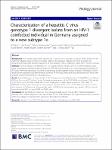Characterization of a hepatitis C virus genotype 1 divergent isolate from an HIV-1 coinfected individual in Germany assigned to a new subtype 1o
Wang, Bo
Krüger, Luise
Machnowska, Patrycja
Eshetu, Amare
Gunsenheimer-Bartmeyer, Barbara
Bremer, Viviane
Hauser, Andrea
Bannert, Norbert
Bock, C. Thomas
Background
HCV exhibits a high genetic diversity and is classified into 7 genotypes which are further divided into 86 confirmed subtypes. However, there are multiple isolates with unassigned subtypes. We aimed to amplify and characterize the full-length genome sequence of an HCV genotype 1 (HCV-1) divergent isolate (DE/17–0414) in Germany.
Methods
The HCV infection was detected in an HIV-1-positive German female within an HCV/HIV-coinfection study using a commercially available antigen-antibody HCV ELISA kit and confirmed by an in-house quantitative real-time RT-PCR assay. Preliminary genotyping was done by sequencing and phylogenetic analysis on partial NS5B region. The full-length genome sequence was determined by consensus RT-PCR assays. Resistance-associated substitutions (RASs) were analyzed using the web-based tool Geno2pheno[HCV].
Results
Partial NS5B region of the isolate DE/17–0414 showed more than 95% identity to 73–08460349-1 l and HCV_Fr_003 from France and QC316 from Canada. Full-length genome analysis of the DE/17–0414 strain showed 91.8% identity to QC316 but less than 79.6% to other HCV-1 strains. Phylogenetic analyses demonstrated that DE/17–0414, 73–08460349-1 l, HCV_Fr_003, and QC316 formed a separate subcluster within HCV-1. DE/17–0414 had a distinct 3 amino acids insertion at the N-terminal of hypervariable region 1 (HVR1) within viral envelope glycoprotein 2 (E2) and several potential antiviral RASs among the NS3 and NS5A genes.
Conclusions
We identified and analyzed an HCV-1 divergent isolate derived from an HIV-1 coinfected individual in Germany, which will be assigned to a new HCV-subtype 1o. Our understanding of the origin and transmission dynamics of this new subtype 1o requires further assessments from patients worldwide.
Dateien zu dieser Publikation

